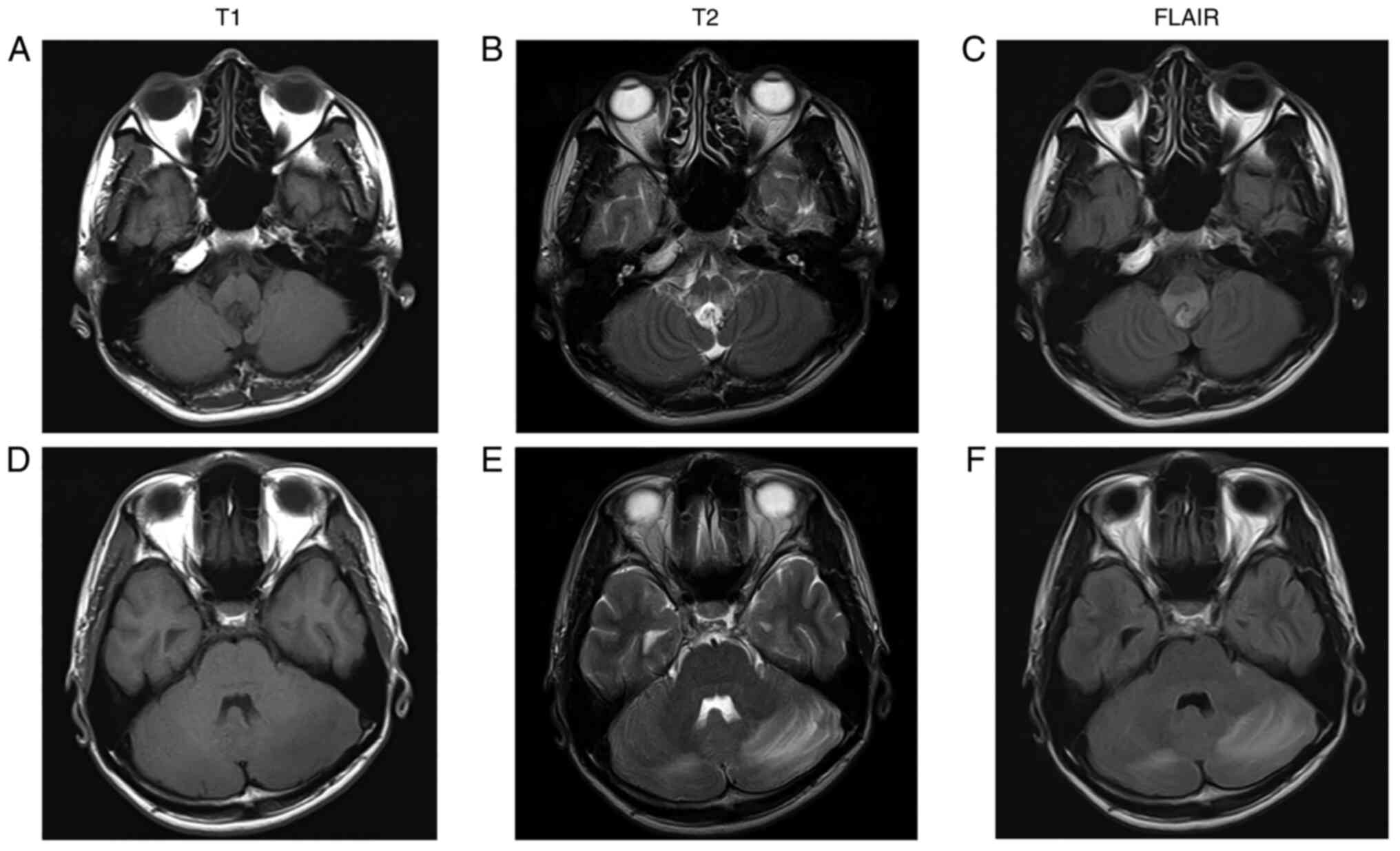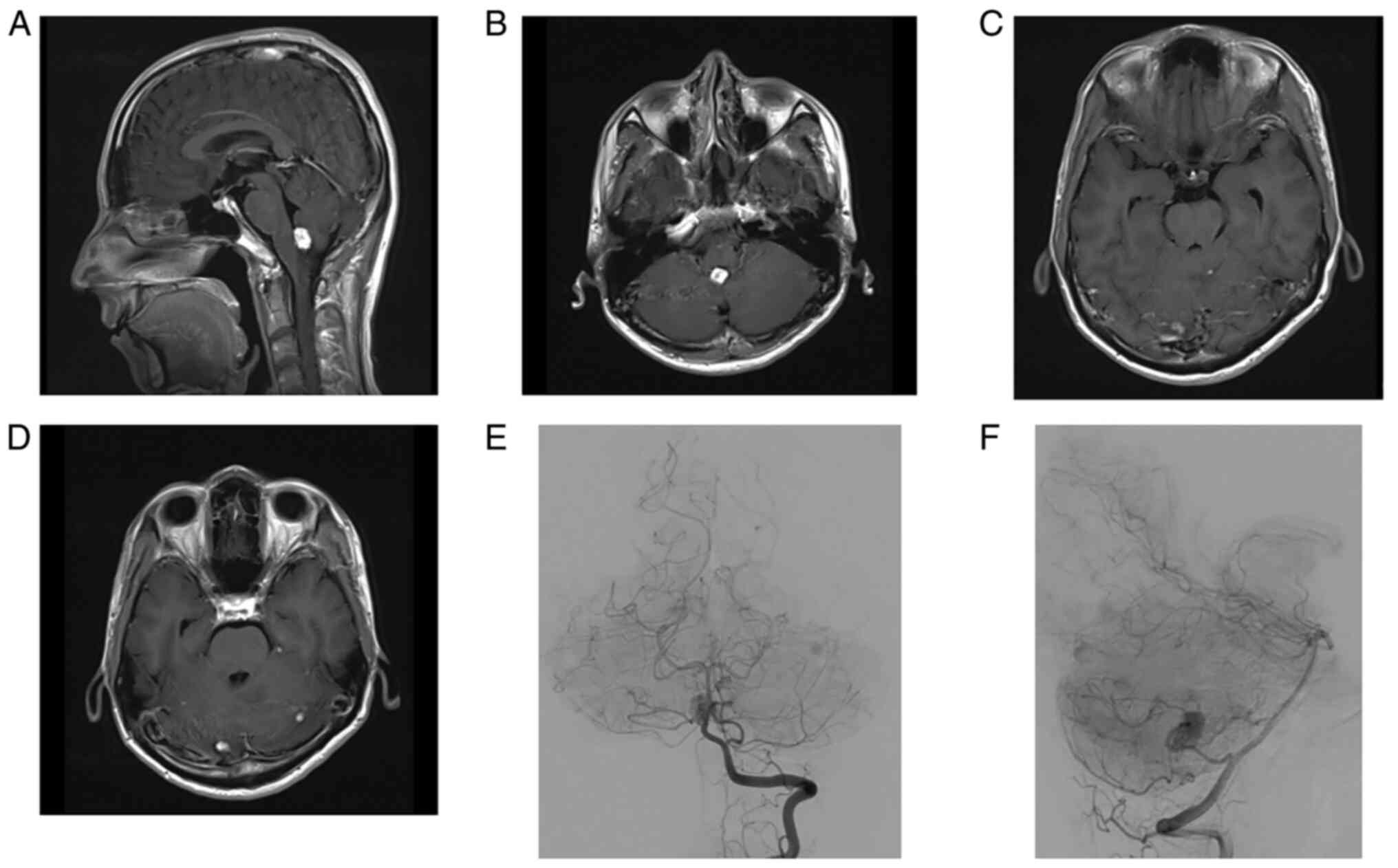Hemangioblastoma of the medulla oblongata that caused isolated fourth ventricle after stereotactic radiosurgery: A case report
- Authors:
- Published online on: March 14, 2023 https://doi.org/10.3892/mco.2023.2633
- Article Number: 37
-
Copyright: © Hama et al. This is an open access article distributed under the terms of Creative Commons Attribution License.
Abstract
Introduction
Isolated fourth ventricle (IFV) is a rare complication following shunt replacement during treatment for post-hemorrhagic, post-infective, post-inflammatory, and congenital hydrocephalus (1). IFV is most commonly seen in infancy with a history of prematurity following ventriculoperitoneal shunt for post-hemorrhagic hydrocephalus. IFV occurs in post-hemorrhagic or post-infective hydrocephalus, causing ependymal inflammation (2,3). Obstruction of the aqueduct and fourth ventricle outlet results in progressive dilation of the fourth ventricle followed by compression of the brainstem and the cerebellar parenchyma (1). Dilation of the fourth ventricle elevates infratentorial pressure and compression of the brain stem, and this can result in eye movement disorder, ataxia, and impaired consciousness. As it is an unusual and complicated disease, it may be missed on initial diagnosis. T2-weighted sagittal MRI to assess dilation of the fourth ventricle and obstruction of the aqueduct or fourth ventricular outlet is accurate for diagnosis of IFV (3). The development of clinical and radiographic features of IFV is slowly progressive, often remaining asymptomatic for months or years. When clinical symptoms develop and radiographic deterioration is detected, urgent operative intervention is necessitated. Several treatment options have been reported, including suboccipital craniectomy and outlet fenestration, fourth ventricular shunting procedures, and endoscopic procedures (3,4). Here, we report a rare case of a hemangioblastoma of the medulla oblongata that caused IFV due to intraventricular deposition of fibrin after stereotactic radiosurgery.
Case report
A 34-year-old man was referred to our outpatient department with intermittent headache from a month previously. Physical examination on admission revealed no neurological deficit. Magnetic resonance imaging (MRI) indicated a mass in the dorsal medulla oblongata and bilateral cerebellar edema (Fig. 1A-F). Post-contrast T1-imaging showed a 15 mm mass in the dorsal medulla oblongata and multiple masses <10 mm in bilateral cerebellar hemispheres that were strongly enhanced with gadolinium (Fig. 2A-D). Cerebral angiography showed that the mass in the dorsal medulla oblongata received a blood supply from the left posterior inferior cerebellar artery (Fig. 2E and F). Systemic computed tomography (CT) showed a right renal tumor, multiple pancreatic cysts, and cystadenoma of the epididymis. The patient's family history was negative for von Hippel-Lindau (VHL) syndrome, and therefore he was diagnosed with solitary VHL syndrome clinically. With consideration of the operative risk, he elected to undergo stereotactic radiosurgery for multiple hemangioblastomas. Stereotactic radiosurgery (SRS) was performed with a dose of 18 Gy for the tumor of the dorsal medulla oblongata and 20 Gy for the other tumors. He began to develop progressive headache and nausea three days after SRS, and CT showed obstructive hydrocephalus (Fig. 3A). We performed endoscopic third ventriculostomy (ETV), the endoscopic view of which showed turbid cerebrospinal fluid (CSF) and that the walls of the lateral and third ventricle were covered with white membrane-like substance (Fig. 3B). The protein level of CSF was 760 mg/dl. Subsequently, a ventriculoperitoneal (VP) shunt was placed a week after ETV because there was no improvement of hydrocephalus after ETV. However, the patient's consciousness deteriorated gradually and the sagittal view of T2 weighted image showed isolated fourth ventricle and upward herniation 2 weeks after the VP shunt (Fig. 3C). The tumor in the medulla oblongata was emergently removed via posterior fossa craniotomy and telovelar approach. The fourth ventricle was filled with a white membrane-like substance, which was all surgically removed (Fig. 4A-C). We performed hematoxylin and eosin staining of the surgical specimen, following a protocol that included deparaffinization, rehydration, hematoxylin staining, eosin staining, and dehydration. Hematoxylin and eosin staining showed stromal cells with abundant vacuolated or lightly eosinophilic cytoplasm and histopathological diagnosis was hemangioblastoma (Fig. 5A). Pathologically, the white membrane-like substance was shown to consist of fibrin (Fig. 5B). The patient's consciousness and obstructive hydrocephalus improved after surgery (Fig. 6). Vocal cord paralysis occurred after surgery and he required tracheotomy, but the paralysis improved within a few weeks. Postoperative CSF protein level decreased to within normal range. The patient was discharged to his home three weeks after surgery with vertical diplopia as the only remaining symptom. Next generation sequence using peripheral was outsourced to SRL, Inc., Tokyo, Japan. The direct sequencing revealed his VHL variant mutation (NM_000551.3: c.464-2A>G). This variant is registered in ClinVar as pathogenic (Accession:VCV000223222.13). At the two-year follow-up, he was working in the same occupation as before the onset, and there had been no recurrence of the tumor.
Discussion
IFV is an unusual type of obstructive hydrocephalus, which is characterized by the disproportionately enlarged fourth ventricle with caudal and rostral obstruction. IFV has often been observed after shunt treatment in patients with a history of ependymal inflammation from infection, or after hemorrhage in children (1-3). Dilation of the fourth ventricle elevates infratentorial pressure and compression of the brain stem, and this can result in eye movement disorder, ataxia, and impaired consciousness. IFV can be diagnosed by T2-weighted sagittal MRI to assess obstruction of the aqueduct or fourth ventricular outlet (4). Conventionally, patients with IFV have been managed by fourth ventricle shunt placement or fenestration of the occluded outlet foramen via posterior fossa craniotomy (3). With the development of neuroendoscopic surgery, patients with IFV have also been treated with endoscopic procedures, including aqueductoplasty and aqueductal stenting (4,5).
In our patient, hydrocephalus with hyperproteinorachia presented after SRS for hemangioblastoma of the medulla oblongata, and VP shunt was performed, but IFV developed. The tumor in the medulla oblongata was removed via posterior fossa craniotomy and telovelar approach. The fourth ventricle was filled with a white membrane-like substance, which was surgically removed. Pathologically, the white membrane-like substance consisted of eosinophilic fibrous matrix without atypical cells, which was shown to be fibrin. This is the first known case report of hemangioblastoma of the medulla oblongata causing IFV due to intraventricular precipitation of fibrin. Tumor removal and opening of the fourth ventricle resulted in improvement of the hydrocephalus and the protein level of CSF decreased after surgical treatment. We did not place a fourth ventricle shunt because the fourth ventricle was filled with fibrin and the shunt was expected to become occluded.
The mechanism behind hemangioblastoma cyst formation remains unclear. Intra-tumoral cysts have recently been suggested to result from vascular leakage and liquefaction of tumor cells (6). In one study, proteomic analysis indicated that the hemangioblastoma cyst fluid contained serum proteins (6). In this case, proteins secreted by the tumor flowed into the fourth ventricle and the fibrin deposition likely occluded the outflow of CSF from the fourth ventricle, leading to presentation of IFV. Our case suggests that IFV may occur after VP shunt placement for the hydrocephalus with hyperproteinorachia.
Resection of symptomatic hemangioblastomas may be curative, but SRS can be applied for small, multiple, high-surgical-risk hemangioblastomas. A retrospective international study of SRS for hemangioblastoma indicated good local tumor control and less adverse radiation effect, but a small number of patients with hemangioblastomas treated with SRS required additional surgical treatment (7). In this case, SRS was performed in consideration of small multiple lesions and the operative risk of lower cranial nerve palsy. However, SRS aggravated the hydrocephalus and required tumor removal. Careful treatment selection and follow-up after SRS are therefore important.
In conclusion, we presented a rare case of a hemangioblastoma of the medulla oblongata that caused IFV due to intraventricular deposition of fibrin. IFV may occur after VP shunt placement for hydrocephalus with hyperproteinorachia.
Acknowledgements
The authors would like to thank Mr. Benjamin Phillis (Clinical Study Support Center, Wakayama Medical University, Wakayama, Japan) for proofreading and editing.
Funding
Funding: No funding was received.
Availability of data and materials
The datasets used and/or analyzed during the current study are available from the corresponding author on reasonable request.
Authors' contributions
YH, TS, TY, JF, HN and NN contributed to the study conception and design. YH and TS wrote the final manuscript and acquired all data. YH and TS confirmed the authenticity of all the raw data. All authors read and approved the final manuscript.
Ethics approval and consent to participate
Not applicable.
Patient consent for publication
The featured patient provided written informed consent for the publication of the data and images of his case.
Competing interests
The authors declare that they have no competing interests.
References
|
Mohanty A: Endoscopic options in the management of isolated fourth ventricles. Case report. J Neurosurg Pediatr. 103:73–78. 2005.PubMed/NCBI View Article : Google Scholar | |
|
Ali K, Nannapaneni R and Hamandi K: The isolated fourth ventricle. BMJ Case Rep. 2013(bcr2013008791)2013.PubMed/NCBI View Article : Google Scholar | |
|
Dauda HA and Sale D: Trapped fourth ventricle: A case report and review of literature. Int J Surg Case Rep. 80(105638)2021.PubMed/NCBI View Article : Google Scholar | |
|
Panagopoulos D, Karydakis P and Themistocleous M: The entity of the trapped fourth ventricle: A review of its history, pathophysiology, and treatment options. Brain Circ. 7:147–158. 2021.PubMed/NCBI View Article : Google Scholar | |
|
Imperato A, Almaguer Ascencio LM, Ruggiero C, Spennato P, Di Martino G, Aliberti F, Mirone G and Cinalli G: Endoscopic aqueductoplasty and stenting in the treatment of isolated fourth ventricle in children: 20-Year institutional experience. Childs Nerv Syst. 37:1587–1596. 2021.PubMed/NCBI View Article : Google Scholar | |
|
Gläsker S, Vortmeyer AO, Lonser RR, Lubensky IA, Okamoto H, Xia JB, Li J, Milne E, Kowalak JA, Oldfield EH and Zhuang Z: Proteomic analysis of hemangioblastoma cyst fluid. Cancer Biol Ther. 5:549–553. 2006.PubMed/NCBI View Article : Google Scholar | |
|
Kano H, Shuto T, Iwai Y, Sheehan J, Yamamoto M, McBride HL, Sato M, Serizawa T, Yomo S, Moriki A, et al: Stereotactic radiosurgery for intracranial hemangioblastomas: A retrospective international outcome study. J Neurosurg. 122:1469–1478. 2015.PubMed/NCBI View Article : Google Scholar |
















